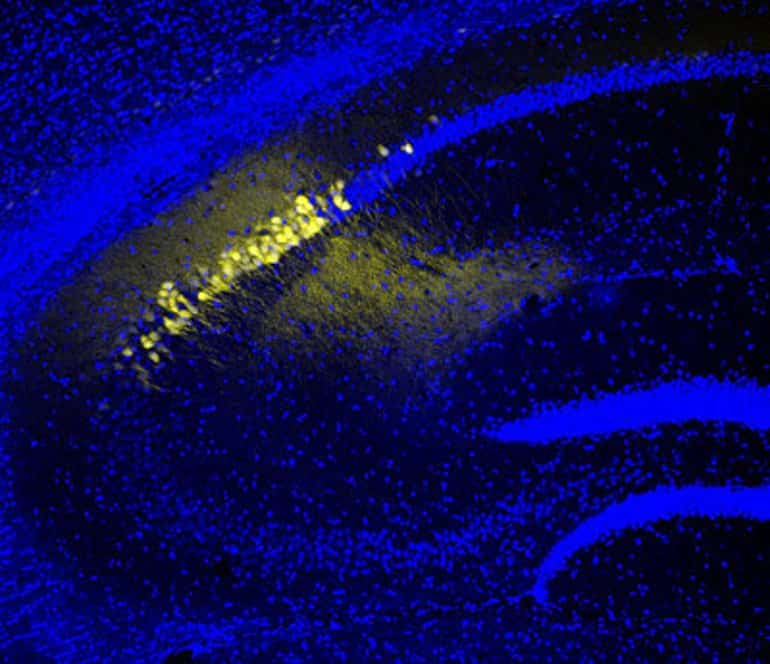Summary: Study reveals how the CA2 region of the hippocampus plays a key role in long-term memory consolidation.
Source: RIKEN
A brain region in mice that plays a key role in coordinating the playback process that consolidates memories during sleep has been identified by RIKEN neuroscientists. This finding could have implications for neurological disorders in people such as schizophrenia.
Activities we do while awake produce short-term memories that are subsequently consolidated into long-term storage within a brain structure called the hippocampus. This process has been linked to distinctive brain wave patterns known as sharp-wave ripple activity in the CA1 region of the hippocampus, which triggers selective reactivation of neural circuits associated with recent experiences.
A team led by Thomas McHugh of the RIKEN Center for Brain Science has been interested in how another hippocampal region, CA2, contributes to sharp-wave ripple activity in CA1. CA2 is thought to be mainly involved in forming memories related to social interactions.
“However, some data—including from our lab—suggests that CA2’s role extends to other domains of memory,” says McHugh.
Previously, McHugh’s team had found that inactivating CA2 in mice gave rise to highly irregular sharp-wave ripple patterns in CA1, which resembled epileptic rather than healthy brain activity. But this manipulation was too aggressive to meaningfully dissect the interplay between these regions.
In their latest work, the researchers employed a subtler approach in which mice were genetically manipulated so that their CA2 neurons could be briefly silenced rather than broadly inactivated. They then examined how this transient inactivation of CA2 affected memory formation during rest after the mice had explored an experimental environment.

This manipulation radically altered the replay process in the hippocampus.
“Normal memory formation occurs through the discrete, sequential reactivation of subsets of neurons linked with particular experiences,” explains McHugh.
“But when we temporarily inhibited CA2, these different experiences were reactivated concurrently in time, which may lead to interference and problems in memory consolidation.” Notably, CA2 inactivation didn’t seem to greatly affect the formation of short-term memory during the active exploration period.
These findings strongly support the notion that CA2’s role goes well beyond social interaction, and it may extend to the broader orchestration of memory-making in general. Since this region is also wired into numerous other brain regions, McHugh is keen to further explore CA2’s involvement in integrating neural information in both health and disease.
“One intriguing link is to mental disorders such as schizophrenia where inappropriate links between memories can underlie symptoms such as disordered thinking or paranoia,” he notes.
About this memory research news
Author: Press Office
Source: RIKEN
Contact: Press Office – RIKEN
Image: The image is credited to RIKEN
Original Research: Closed access.
“CA2 inhibition reduces the precision of hippocampal assembly reactivation” by Thomas McHugh et al. Neuron
Abstract
CA2 inhibition reduces the precision of hippocampal assembly reactivation
Highlights
- Silencing of CA2 decreases the temporal precision of SWRs and neuronal spiking
- Assemblies from distinct experiences are co-activate following CA2 inhibition
- CA1 spiking is more synchronous during replay in the absence of CA2
- CA2 influences the informational and temporal precision of neuronal reactivation
Summary
The structured reactivation of hippocampal neuronal ensembles during fast synchronous oscillatory events, termed sharp-wave ripples (SWRs), has been suggested to play a crucial role in the storage and use of memory. Activity in both the CA2 and CA3 subregions can precede this population activity in CA1, and chronic inhibition of either region alters SWR oscillations. However, the precise contribution of CA2 to the oscillation, as well as to the reactivation of CA1 neurons within it, remains unclear.
Here, we employ chemogenetics to transiently silence CA2 pyramidal cells in mice, and we observe that although SWRs still occur, the reactivation of CA1 pyramidal cell ensembles within the events lose both temporal and informational precision.
These observations suggest that CA2 activity contributes to the fidelity of experience-dependent hippocampal replay.







